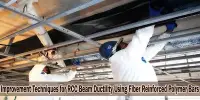Concrete with shrinkage-reducing additives expands roughly as much as concrete with typical drying shrinkage contracts it. The hardened concrete has a net length change that is negligible enough to avoid shrinkage fractures. Polyoxyalkylene alkyl ether or a related substance is often used in shrinkage-reducing concrete mixtures.
It is possible to get reductions of 30 to 50% in early and long-term drying shrinkage when such an additive is introduced to concrete at the batching stage.
Materials
The main component of shrinkage-reducing admixtures is ethylene glycol derivatives. Compared to the majority of conventional admixtures, which are water-based solutions, these organic liquids are completely different.
The admixtures are normally 100% active and are water soluble. They have a characteristic odor and a specific gravity of less than 1.00.
Mechanism of Shrinkage Reduction
The mechanism by which shrinkage reducing admixtures operate is unique. After laying, compacting, finishing, and curing the concrete, an air/water interface, or “meniscus,” is created inside the capillaries or pores of the cement paste of the concrete as extra water starts to evaporate from the top.
The inside walls of the capillaries or holes where the meniscus has formed are put under stress since water has a very high surface tension.
The capillary or pore tends to close while under this tension, which takes the shape of an inward pulling force. As a result, the capillary’s volume decreases, which causes the cement paste surrounding the aggregates to shrink and diminish the volume overall.
The shrinkage-reducing admixtures work by interfering with the air/water interface’s surface chemistry inside the capillary or pore, which reduces surface tension effects and, as a result, shrinkage as water evaporates from the concrete.
Dosage
Water content and batch designs affect usage rates, which typically range from 8 to 25%. The amount of shrinkage that is wanted, the amount of set retardation that is acceptable, and the curing circumstances will all influence the dosage that should be chosen.
Effects on Fresh Concrete:
- When 2% of this additive is added to the concrete mixture without adjusting, the slump value will increase.
- It might retard rate of hydration slightly and extend setting time by an hour.
- It influences air content of concrete mixture. If air entraining admixture and concrete reducing admixture are combined, more air entraining admixture should be applied to attain the desired air content.
Effects on Hardened Concrete:
- Reduce shrinkage by 30 to 50%. This reduction is influenced by the ambient conditions, mixture design, and the materials used.
- It causes the reduction of concrete compressive strength. It has been proven that adding 2% of a shrinkage-reducing additive will result in a 15% drop in strength after 28 days. The loss of strength can be compensated for by adding high range water lowering additive or decreasing the water to cement ratio.
- Reduce thermal cracking.
- It decreases curling of concrete slab.
Advantages:
- Concrete with a shrinkage-reducing additive would be less likely to develop cracks, which would reduce joint contraction and curling.
- Reduces number of cracks in leakage susceptible structures.
- Decrease the loss of prestress in prestressing applications.
- High-shrinkage aggregates were countered with a shrinkage-reducing concrete additive. To determine the most cost-effective alternative in this situation, the costs of the shrinkage-reducing concrete additive and high-quality aggregate should be compared.
- When durability issues potentially result from shrinkage cracking or when there are too many shrinkage joints for practical or economical reasons, shrinkage reduction admixtures can be utilized.
- Shrinkage-reducing admixtures can lessen the danger of cracking where new concrete is used to reinforce or repair existing structures in what can be a very constrained environment.
Applications:
- Architectural precast
- Pneumatically applied concrete
- Water-retaining structures Majority of horizontal slab applications such as floors, roofs, and parking decks.
















